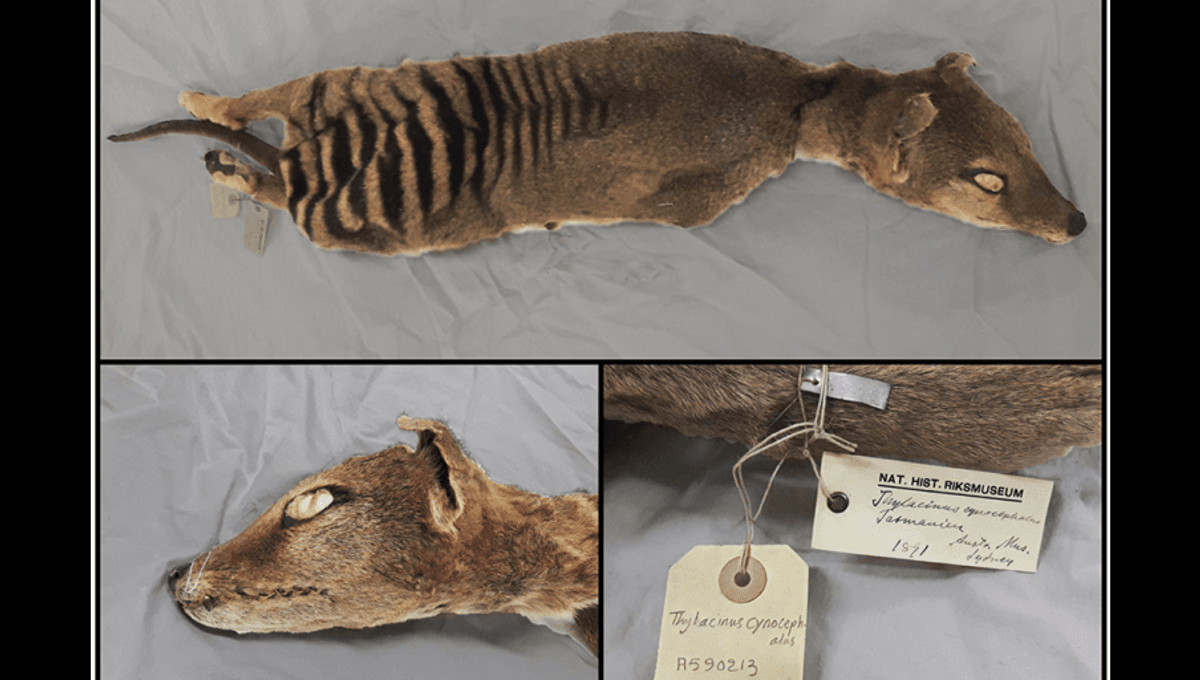
RNA from a Tasmanian tiger (thylacine) specimen preserved more than a century ago has been sequenced. This marks the first time the feat has been achieved for any extinct species, including those whose demise was much more recent. The fact the specimen had been stored at room temperature demonstrates RNA sequencing should be possible for many other extinct animals. What is less certain is how much this will contribute to the goal of de-extinction, which is being pursued for the thylacine, but what many zoologists regard as a fantasy.
Since its extinction, the thylacine has gone from reviled to beloved. A species once deliberately exterminated with a bounty for each pelt, is now so precious that people comb the Tasmanian wilderness in the hope of finding a remaining population. Even implausible reports of sightings stimulate waves of excitement. Sports teams are named after the extinct carnivore and theatre performed about them.
We may now learn a little more about what we lost, thanks to the sequencing of the transcriptome (all the RNA in cells) of the skin and skeletal muscle of a specimen stored in the Swedish Museum of Natural History. The specimen was desiccated and 130 years old, but Dr Mark Friedländer of Stockholm University and colleagues were able to find gene-expression signatures they could compare to those of living marsupials, and more distantly related mammals.
Although much of the RNA they found resembles that from the thylacine’s closest surviving relatives, the team report: “We discover a thylacine-specific microRNA isoform that could not have been confirmed without RNA evidence.”
Extracting DNA from fossils thousands or even millions of years old is now so common that doing the same thing from museum specimens barely attracts attention, but RNA is another matter. “This is the first time we have had a glimpse into the existence of thylacine-specific regulatory genes, such as microRNAs, that [became] extinct more than one century ago,” Friedländer said in a statement.
RNA allows researchers to identify individual cells and tissue, how genes are regulated, and whether specific genes have been expressed. In this case, thylacine RNA was found to be quite specific to individual tissues. The team even found traces of RNA viruses, potentially allowing them to study the diseases that affected the thylacine in its latter days.
“Resurrecting the Tasmanian tiger or the wooly mammoth is not a trivial task, and will require a deep knowledge of both the genome and transcriptome regulation of such renowned species, something that only now is starting to be revealed,” said lead author, PhD student Emilio Mármol.
Although many species have gone extinct in recent times, and the numbers growing every year, the thylacine is among the few that have attracted the attention of advocates of de-extinction. Being a marsupial, the argument goes, it would be much easier to bring it back than another mammal that needed to gestate much longer in the womb of a foster mother from a related species.
However, de-extinction of the thylacine also poses challenges not every species faces. We have only a few thylacine specimens, and they lacked genetic diversity following the separation of Tasmania from the mainland at the end of the last ice age. Consequently, any revived thylacines would quickly become inbred, a problem the RNA sequencing would not help with. De-extinction would also likely create pressure to scrap programs to protect endangered animals, on the basis that we could always bring them back later if desired.
Fortunately, however, the work has value even if de-extinction proves a dead end. “In the future, we may be able to recover RNA not only from extinct animals, but also RNA virus genomes such as SARS-CoV2 and their evolutionary precursors from the skins of bats and other host organisms held in museum collections,” said the University of Stockholm’s Professor Love Dalén.
The study is published in Genome Research.
Source Link: Tasmanian Tiger Specimen Provides The First RNA From An Extinct Species